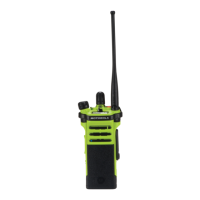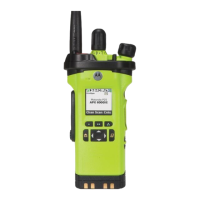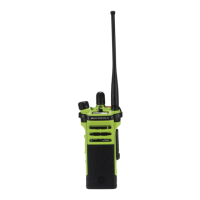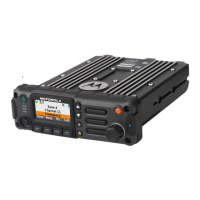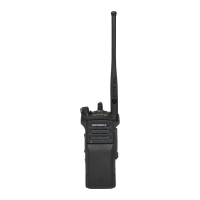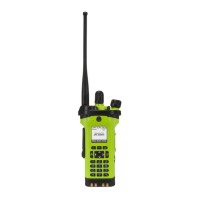Theory of Operation: Controller 3-43
3.2.5 Audio
The audio section of the VOCON design consists of:
• TI AIC33 voice CODEC
• TI TPA2034D1 class-D audio power amplifier
• MAKO audio sub-block
3.2.5.1 TX Audio path
The TX audio paths begin with three microphones. There are two internal microphones and one
external microphone path going to the GCAI connector.
The internal microphone paths start with two microphones that are embedded within the radio. Both
of the microphones are biased with a 4.7 V supply that is generated by the MAKO IC. This supply is
solely dedicated to biasing the microphones. The microphone signals are AC coupled into the 16 bit
TI AIC33 stereo CODEC on the MIC3R and MIC3L input pins. The TI AIC33 CODEC allows both
microphone signals to be amplified, and simultaneously sampled and converted into digital data. The
data is sent to the OMAP1710's DSP through the McBSP1 port where the DINC (dual input noise
canceller) can process the data for both microphones and provide a high level of noise suppression.
The digital data is sent to the OMAP1710 through the audio SSI (synchronous serial interface) bus
where the MAKO IC is used as the interface's clock and frame sync generator.
Figure 3-30. Audio TX Path Block Diagram
The external microphone path will also be supported by the TI AIC33 CODEC, using the LINE1LP
pin on the IC. The LINE1LP is multiplexed with the MIC3R within the CODEC, and selected as the
input when the external microphone path is chosen as the TX audio source. Similar to the internal
microphone signals, the TI CODEC amplifies and samples the external microphone signal. The
digital data is also sent to the OMAP1710's DSP through the McBSP1 port using the audio SSI bus.
Portable TX Audio Architecture
OMAP DSP
MAKO
Audio Stereo Codec (TI AIC33)
SSI
SSI
MCBSP1
VC_DCLK
VC_FSYNC
VC_TX
VC_RX
SSI
LEFT
ADC
RIGHT
ADC
DSP SPI
SPI
MIC BIAS
Reset Out
Reset
External/
Accessory
Microphone
Internal
Microphone 1
Internal
Microphone 2
I2C
I2C
Line 1L
Mic 3R
Mic 3L
Note: All three microphones will be
routed to the AIC33 CODEC. In Tx
mode, MAKO will only be used to
generate the microphone bias. Both
internal microphones will be sampled
on adjacent SSI slots. The external
microphone can be sampled on either
slot.
5
4
6
1
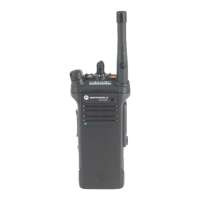
